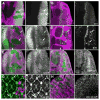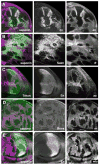Expanded and fat regulate growth and differentiation in the Drosophila eye through multiple signaling pathways
- PMID: 17359963
- PMCID: PMC2075468
- DOI: 10.1016/j.ydbio.2007.02.004
Expanded and fat regulate growth and differentiation in the Drosophila eye through multiple signaling pathways
Abstract
Mutations in the expanded gene act as hyperplastic tumor suppressors, interfere with cell competition and elevate Dpp signaling. Unlike Dpp overexpression, ex causes few patterning defects. Our data suggest that patterning effects are partly masked by antagonistic roles of other signaling pathways that are also activated. ex causes proliferation of cells in the posterior eye disc that are normally postmitotic. ex mutations elevate Wg signaling, but Dpp signaling antagonizes patterning effects of Wg. By contrast, if Dpp signaling is blocked in ex mutant cells, the elevated Wg signaling preserves an immature developmental state and prevents retinal differentiation. An effect of ex mutations on vesicle transport is suggested by evidence for altered sterol distribution. Mutations in ft show effects on proliferation, Wg signaling and sterols very similar to those of ex mutations. During disc growth, ex was largely epistatic to ft, and the Warts pathway mutation hippo largely epistatic to ex. Our data suggest that ft and ex act partially through the Warts pathway.
Figures








References
-
- Baker NE. Transcription of the segment polarity gene wingless in the imaginal discs of Drosophila, and the phenotype of a pupal-lethal wg mutation. Development. 1988;102:489–497. - PubMed
-
- Baker NE, Yu SY. The EGF receptor defines domains of cell cycle progression and survival to regulate cell number in the developing Drosophila eye. Cell. 2001;104:699–708. - PubMed
-
- Baonza A, Freeman M. Notch signalling and the initiation of neural development in the Drosophila eye. Development. 2001;128:3889–98. - PubMed
-
- Baonza A, Freeman M. Control of Drosophila eye specification by Wingless signalling. Development. 2002;129:5313–22. - PubMed
-
- Bennett FC, Harvey KF. Fat cadherin modulates organ size in Drosophila via the Salvador/Warts/Hippo signaling pathway. Curr Biol. 2006;16:2101–2110. - PubMed
Publication types
MeSH terms
Substances
Grants and funding
LinkOut - more resources
Full Text Sources
Molecular Biology Databases

